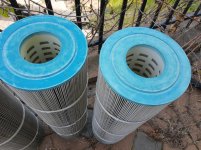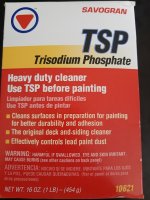Thanks for the reply.
I have a question - these Haywards are over 15 years old. I use them when I open and once pool passes overnight test replace them with newer set. I clean them and put them back in filter when closing.
This season I removed them within 24 hours of adding CYA, because pressure jumped more than before and for some reason my CYA went through the roof.. (may be someone can explain why)

These old Haywards are much heavier then the newer set. Not sure if that's how they were built or because of all the usage.
Is it worth cleaning them with TSP? I remember many posters on TFP suggested replacing cartridges after a few years of use, but now it seems like old carts are considered good if the bands are intact
P.S. my CYA issue (probably needs a separate post)
I lose CYA during winter. On my tfp test kit black dot was clearly visible, Leslie's saw it as 5.
I had added about 8lb (5+~~3) of BioGaurd Stabilizer expecting it to get to around 40-45, but now I have about 60 as if I added over 11lb (which is impossible, unless there was way more than 5lb in a new sealed bag)
Unfortunately I never measured it with measuring cup.. from now on I will
I've been using liquid chlorine for years and never had CYA over 40-45 (which seem to use less chlorine than 30), so dealing with 60 is going to be a new experience for me

I understand it'll use more test agents DPD 0871 (which I use every day), but what about chlorine?
(I know I should avoid Leslie's, but I don't trust myself with CYA testing, so I get it tested there too and the reading on their new testers have always been about 15-20% higher than mine. Also their CYA reading is consistent across a few stores I visited with the same water sample, unlike their calcium, phosphates (whatever that is). They also say my TDS is at 4000... pool has never been drained, not sure if I need to.
Thanks.



